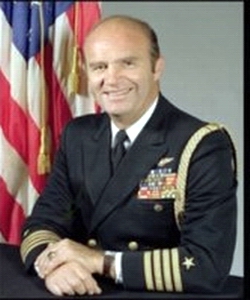 Captain McKeown is a native of Ysleta, Texas where he was an outstanding student athlete. Upon graduation, he was selected to attent the United States Naval Academy at Annapolis, Maryland.
Captain McKeown is a native of Ysleta, Texas where he was an outstanding student athlete. Upon graduation, he was selected to attent the United States Naval Academy at Annapolis, Maryland.
While at the Academy, he excelled in football and boxing. Playing alongside Heisman Trophy winner Joe Bellino, he was "The other running back," on the 1960 Navy team.
McKeown was the recipient of the "Spike Webb Award", emblematic of the outstanding boxer in the Naval Academy; where he was the undefeated light-heavyweight champion of the Brigade of Midshipmen for three consecutive years.
Following graduation from the Academy, Ensign McKeown attended Navy Flight Training and received his wings as a Naval Aviator in November of 1962.
He was then assigned to Fighter Squadron 154 flying F8U Crusaders. He participated in the first raids against North Vietnam in 1964. Prior to his second cruise to Southeast Asia, the squadron transitioned to the F4B Phantom.
McKeown was selected to attend the U.S. Air Force Aerospace Research Pilot School for test pilot and astronaut training. While there, he flew a specially modified F104 to an altitude of 127,000 feet.
He then reported to Air Test and Evaluation Squadron FOUR. In his role as Chief Test Pilot, he was in charge of all engineering changes to the SPARROW air-to-air missile.
As the F4 Tactics Manager he was charged with developing Navy tactical doctrine for the F4 Phantom and had the opportunity to fly the Soviet built MIG-17 amd MIG-21 aircraft.
In 1969, he was assigned to Fighter Squadron 161 as Operations Officer. In early 1972, with only 48 hours notice he embarked aboard USS Midway for his fourth combat deployment to Southeast Asia.
On May 23rd, while leading a section of F4s on a Combat Air Patrol north of Hanoi near the enemy airbase at Kep, McKeown and his RIO, Lt Jack Ensch, along with their wingmen were attacked bny six North Vietnamese MIGs. In what has been described as one of the longest and most exciting dogfights of the war, fighting often at tree-level height. When it was over McKeown had shot down two MIG-17s, including one off his wingman's tail and then chasing the remaining enemy aircraft into China.
For this action, McKeown and Ensch were awarded the Navy Cross. Following this action, Lieutenant Commander McKeown received orders to become the first Commanding Officer of TOPGUN, the Navy Fighter Weapons School.
McKeown would serve as TOPGUN Commanding Officer for three years. During that period he set the foundation to make TOPGUN the premiere Air-to-Air tactics training school in the world.
After a brief tour in the Pentagon, McKeown assumed command of Fighter Squadron ONE and as fate would have it, Lieutenant Commander Ensch reported aboard as the Maintenance Officer.
He then went on to be Chief of Staff for Operations, Commander Carrier Group Eight. During his tenure in COMCARGRU staff working for RADM Jim Service and RADM Jerry Tuttle, the bnattlegroup developed electronic warfare tactics and procedures that bore fruit in the Gulf of Sidra, Desert Shield, Desert Storm and Iraqi Freedom.
His final tour was as Chief of Staff and Executive Assistant to the Chief of Naval Material.
Captain McKeown's personal awards include the Navy Cross, Legion of Merit, Distinguished Flying Cross (5), Air Medal (27), Navy Achievement Medal (14). He flew 440 combat missions in Southeast Asia and amassed 997 carrier landings.
Ronald Eugene McKeown, Captain USN (Ret.) “Mugs.” Video tribute of USS Midway fighter pilot and “MiG killer” may be viewed HERE. Mugs passed away on Nov. 21st, 2015.

